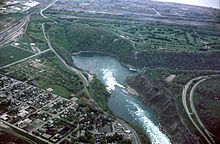Niagara hot tub
This article was due to content flaws on the quality assurance side of Geosciences portal entered. This is done to increase the quality of the articles in the geosciences topic. Please help to correct the deficiencies or take part in the discussion . ( + )
Reason: The Niagara whirlpool is certainly not a whirlpool in the literal sense of the word. The name Wirl pool already suggests that it is a depression filled with water, in whose water bodies whirlpools occur (in the sense of the WP article linked above). Rather, it is a kind of very large vortex pot . - Gretarsson ( discussion ) 1:31, 28 Mar. 2018 (CEST)
The Niagara Whirlpool is a naturally formed whirlpool on the border between the Canadian province of Ontario and the US state of New York . It lies below Niagara Falls in the Niagara Gorge and its greatest water depth is 38 meters. At this point the Niagara River bends 90 degrees, creating a vortex that is as large as it is dangerous.
History of origin
It is believed that the Niagara Whirlpool was created around 4,200 years ago during the upstream erosion by the water runoff from the Erie to Lake Ontario on the edge of the Niagara cliff.
Niagara Falls are on the edge of the cliff and have been migrating upstream since they were formed. During this slow but steady process, Niagara Falls crossed a former river course that was formed during the Ice Age about 22,800 years ago, the Saint David's Gorge , which was completely buried with sedimentary rock . The sediments were deposited in the gorge when a glacier retreated and filled it completely over a length of 1,200 m, a width of 300 m and a depth of 90 m. When the river suddenly hit the soft glacier sediment consisting of gravel and petrified mud, it was washed out more and more and the Niagara River changed its course within a very short time. This led to the creation of the Niagara hot tub.
The Niagara River washed out the old canyon and now partially flows through this Ice Age canyon. Part of this gorge extends into Lake Ontario, but is not part of today's Niagara river bed. The peculiarity is that the Niagara River met the gorge at an almost right angle and therefore branches off at this point today by this 90 °.
The sudden change in direction of the river, combined with the high flow speed of nine meters per second, leads to a turbulent swirling of the Niagara water. In addition, the further erosion has also abraded the harder bedrock of the river floor into a rounded water basin, as a result of which the vortex extends from the center to the shoreline.
When the water level is normal, the vortex rotates clockwise, when there is high water or when the electricity company drains less water and thus allows it to flow directly over Niagara Falls, the rotation changes counterclockwise for reasons that have not yet been explored.
See also
Web links
Coordinates: 43 ° 7 '9.3 " N , 79 ° 4' 2.5" W.
